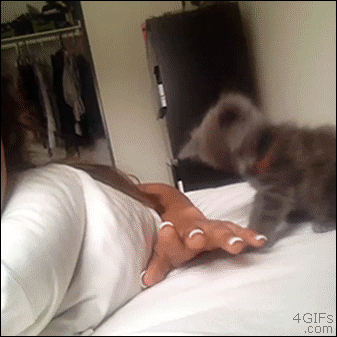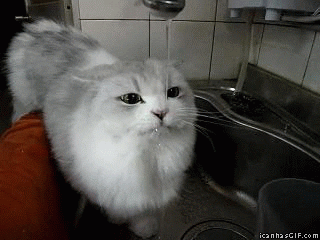Norovirus Survival Tips (And What It's REALLY Like)

Content warning: symptoms will be shared as a means of conveying what we’re dealing with here. It’s unpleasant. I’m so sorry.
To counteract the revulsion, we’ll be peppering this post with pics of puppies and kittens and rainbows.
Disclaimer: This article is not meant as medical advice. This is a mom-life blog. I’m here to help you put some things in place so you can avoid and survive norovirus outbreaks and other nasty bugs. See a list of sources linked throughout the post for further reading from medical experts and other reputable sources.

Norovirus Survival Tips
Noroviruses are a leading cause of severe gastroenteritis, marked by sudden vomiting and diarrhea. It might go by the name “winter vomiting disease” or “stomach flu,” which is not actually a thing because influenza is a distinct family of respiratory viruses, but ok fine. If someone is talking about “stomach flu” they might be talking about norovirus.
I’ve mostly heard of this nightmare plaguing captive “closed and crowded” audiences, such as people on cruise ships or in retirement communities.
It is no joke, especially for individuals with compromised immune systems or those at risk for dehydration, such as older adults and young children.
Our family's experience with (suspected) norovirus
This year so many families I know have come down with this highly communicable stomach bug known for projectile vomiting and explosive diarrhea. (Sorry, but I warned you.)
Unlike a cold that comes on with a bit of a sore throat or a drippy nose and progresses from there, norovirus seems to come out of nowhere.
For us it started with my 9yo after dinner one Sunday in early December, then myself after bedtime. She and I were up with vomiting and diarrhea all night, 4-5 times for each of us. I’ve never experienced anything like it. Not only the aforementioned projectiles and explosives, but also shivery chills, abject weakness / body aches, and constant nausea. And a bout of vomiting didn’t result in us feeling any better. It was relentless. From there here’s how it progressed:
- Day 2 — Monday: We felt terrible all day, but no more emissions. All we could do was sip ginger ale, nibble popsicles, and feel sorry for ourselves
- Monday night: slept amazing, like 10 hours straight
- Day 3 — Tuesday: We felt increasingly better, but I couldn’t even read out loud to her without feeling nauseated. The smells and sounds of the rest of the family eating were enough to make me want to flee. Alas, I hadn’t the strength
- And yet a mere hour later I found myself eating half a banana, ever so thinly sliced
- Tuesday night: slept great again
- Wednesday: she was back to school and I was back to work, both of us at approximately 93% capacity
That’s a pretty typical trajectory: 1-3 days of absolute misery, then back to normal.
Two weeks later, norovirus came for my husband. (We surmise it was a different exposure, not leftover from ours.) It seemed to strike him even worse, and it lasted longer. It was so bad (and poorly timed) that he missed the first half of our Christmas week back home in Pittsburgh.

Christmas at PPG Place, Pittsburgh, credit Lori Kemp, Getty Images
But there was no way he was going to fly. Even though he was no longer emitting, traveling when sick is just the worst, and we didn’t want to risk potentially subjecting fellow travelers or my extended family to this virus.
Much good that did us, because the second night we were there our teenage exchange student came down with it, too!
By some miracle (and vigilant Lysol use), it stopped there. Our 7 year old never got it, and neither did the 9 other people staying in the house, up to age 83.
Norovirus: How bad could it be?
Here’s the crazy thing: For as bad as our experience felt, I’ve learned we had it easy! I’ve heard of families around here that had symptoms for a whole week, for many weeks.
One child I know had to go to the hospital for IV fluids (intravenous fluids) because she was vomiting so much and couldn’t keep down a sip of water.
In some families, it rotated around family members, coming back around for people to get multiple bouts. This could have been the same virus circulating on hard surfaces, or it could have been new incidents. Either way, truly wretched.

How Norovirus spreads
Why, god, why?
Norovirus is an extremely contagious virus. It’s hard to kill, and it easily spreads from person to person.
It can be spread from the onset of symptoms to a few days after recovery.
The reason the vomiting is projectile and the diarrhea is explosive is that the virus wants to spread. (I know viruses are insentient and therefore can’t “want,” but yeah, you know what I mean.) The farther the droplets spread, the likelier they are to be picked up by other people.
So norovirus particles spread through splatters of the vomit and diarrhea contaminating surfaces, people touching those surfaces, and getting infected themselves or spreading the infection further.
According to the Mayo Clinic, you can get norovirus infection by:
- Eating contaminated food or drinking contaminated water
- Touching your hand to your mouth after your hand has been in close contact with a contaminated surface or object
- Being in direct contact with the viral particles from a person who has norovirus infection

How long it takes for symptoms to appear
Illness usually begins 24-48 hours after exposure, but could be as quick as 10 hours.
How long it takes for symptoms to appear
Typically 1-3 days.
How long Norovirus is contagious
People can continue to shed the virus in their stool for weeks after recovery.
But here’s a fact to face: Norovirus can last on surfaces for days to weeks. Later in this post we’ll go into ways to disinfect and prevent the spread of the virus.
What "let the virus run its course" actually means
Unlike treating a bacterial infection with antibiotics, it’s common knowledge that we need to let a virus “run its course.” But what does that mysterious advice actually mean?
It means “waiting for your body’s immune system to fight off the viral infection by itself by activating an immune response.”
In brief: Viruses can reproduce only within a host cell. A virus gets into your cells, takes over, makes changes that make you feel sick, and starts multiplying. When your body senses this is happening, your immune system uses a variety of defenses to kill those cells and stop the madness.
How to treat norovirus
So, if we’re letting the virus “run its course,” what can we actually DO?
The treatments aren’t complicated:
- Rest and sleep as much as you can
- Stay hydrated
Honestly, that’s it. There isn’t truly a specific treatment.
We’re making sure things don’t get worse through severe dehydration, and we’re giving our bodies a chance to do its immune-response thing.

Just sleep.
When to get medical attention
I’m pulling this straight from the Mayo Clinic: “Seek medical attention if you develop diarrhea that doesn't go away within several days. Also call your health care provider if you experience severe vomiting, bloody stools, stomach pain or dehydration.”
For me, regarding my children: When it doubt, call the nurse help line.
And according to Emory Healthcare, visit your primary care physician or urgent care if you or your family member:
- Has symptoms for more than three days
- Has bloody stool or vomit
- Isn’t urinating or the urine is dark (signs of dehydration), oral temperature of over 101.5°F.
It’s time for the ER if you or someone in your care is suffering with:
- A temperature over 102°F for more than 2 days that doesn’t respond to medicine
- Severe dehydration (symptoms include dark urine or lack of urine)
- Unusual dizziness or lightheadedness on standing
Trust your instincts, mama
When it comes to your children’s health, if you are worried, that’s your brain trying to help you. Trust your instincts. When my son was 2, I knew he was not ok. I knew the pediatrician’s continued advice to “wait and see” had passed its usefulness — I’d waited, I’d seen, he was in true distress. (Turned out to be kidney failure.) You can read more about this harrowing episode here. Spoiler alert: he recovered completely and is in 100% good health, thanks, in part, to my instincts.
Supplies for Norovirus and other tummy troubles
I try to keep these items on hand just in case. I also don’t hesitate to use Instacart or plead for a favor from a friend or neighbor in times like these.
If you hear that a friend is dealing with this plague in her house, and you drop a bag of these supplies at her house, you will make such a difference in their recovery.
- Popsicles (grape and lemon are my go-tos)
- Mini cans of ginger ale (get the same brand your grandmother got when you were a kid; the placebo effects still work!)
- Lemon Spindrift
- Coconut water
- Jello (regular, not sugar free, as artificial sweeteners can have a laxative effect in some people)
- Broth
- Oyster crackers
- Hand sanitizer
You might like to keep Pedialyte, fruit juice, or Gatorade (or other sports drinks) for hydration and electrolytes, but they aren’t on my personal list.

How to prevent the spread of Norovirus and other germs
Wash your hands like you mean it
It’s time to wash your hands like you did back at the beginning of the Covid-19 pandemic — religiously. Soap, hot water, at least 20 seconds, paper towel for drying.
Typically I prefer to use hand towels that I change out twice a week. Not so when people are sick. In that case I pull out these single-use dry paper towels my mom likes. But regardless, hand washing is key.
Isolate the problem. I mean, the infected person.
If you have the luxury, isolate the sufferer to their own room and bathroom.
Moms of young children everywhere, your eye-roll at that suggestion is noted. So, just do what you can.
When my little kids are sick, my maternal instinct is to stay with them, so that’s what I do. (And that’s probably exactly how I got norovirus that fateful night.)
But when it came to my husband and our teenage exchange student, I mostly shut them away and slid a tray through a little slot in the door that I cut out for this purpose. I’m kidding. But really — the more the person with the germs can keep to themselves, the better.
Don't just clean, disinfect.
Quick refresher from the CDC (Center for Disease Control and Prevention in the United States):
- Cleaning removes most germs, dirt, and impurities from surfaces. Clean with water, soap, and scrubbing.
- Sanitizing reduces germs to levels public health codes or regulations consider safe. Sanitizing is done with weaker bleach solutions or sanitizing sprays. Clean surfaces before you sanitize them.
- Disinfecting kills most germs on surfaces and objects. Disinfecting is done with stronger bleach solutions or chemicals. Clean surfaces before you disinfect them.
While on a typical day I prefer to clean with white vinegar or a simple soap-based spray and reusable rags, I am not messing around when it comes to norovirus. I keep a strong all-purpose cleaner like Lysol All-Purpose Cleaner and Disinfectant and paper towels on hand for times like these.
A bleach solution is another proven disinfectant. (Do not mix chemicals.)
When I was the caregiver, I followed the sufferer’s bathroom use with my lemon-scented Lysol, being sure to clean the following surfaces, in the following order, moving from surfaces least likely to be contaminated to most:
- Light switches
- Doorknobs / door handles
- Faucet handles
- Toilet flusher
- Sink and counter
- Toilet lid, seat, basin
- Floor around toilet
Then, dispose of the paper towels in a plastic trash bag, tie it up, and drop it in the bin. Then wash your hands and use one of those single-use paper towels.
Supplies for limiting the spread of germs like Norovirus
There was a time when I tried to be as eco-friendly and zero-waste as possible. I still have less packaging and disposable items than the average American, but now I also balance out my desire for being eco-friendly with my desire for keeping things simple as a mom. And when it comes to germs passing around the family, disposable is the best way to go.
- Sick bags
- Disinfectant spray, like Lysol
- A roll of paper towels for cleaning
- These single paper towels for hand-drying
- Plastic bags for disposing of paper towels and sick bags
- Soap for handwashing

Recovery: Change it all out and start over
When I’ve been sick and I have the energy and interest in a shower, I know things are looking up. Now it’s time to:
- Change out of those sweaty pajamas or joggers
- Take a shower
- Change the sheets
- Wash the sheets and towels and bath mat (The CDC states that it is safe to wash dirty laundry from a sick person with other items)
- WASH YOUR HANDS after handling the dirty laundry!
- Throw out your toothbrush
- Sanitize your phone with rubbing alcohol and a lint-free cloth
- Get some fresh air

Mom Win: Norovirus Survival List

Copy/paste this list over to your grocery list. I try to keep these supplies on hand always, just in case.
- Popsicles (grape and lemon)
- Mini cans of ginger ale
- Spindrift (lemon)
- Coconut water
- Jello (regular, not sugar free)
- Broth (box or bouillon)
- Oyster crackers
- Thermometer
- Hand sanitizer
- Sick bags
- Disinfectant spray, like Lysol
- A roll of paper towels for cleaning
- These single paper towels for hand-drying
- Plastic bags for disposing of paper towels and sick bags
- Soap for handwashing
This post was all about Norovirus survival tips.
If this meant something to you, you might also like:
The Mindset Traps That Make Laundry Harder for Moms
25+ Mom Purse Essentials All Moms Need In Their Bags
If this post helps make your mom-life easier,
subscribe to the weekly-ish newsletter and never miss a post.





